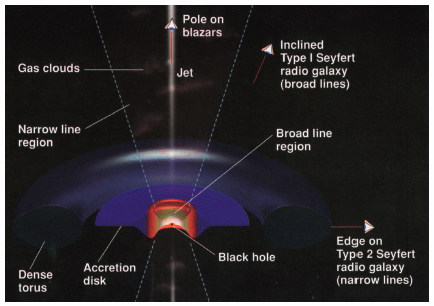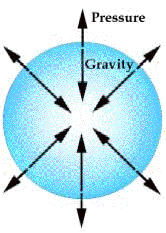Studying AGN
Contents
Introductory comments from Varoujan
I have been very interested in Active Galactic Nuclei (AGN) for some time. Here is a brief introduction to the key points.
Basically AGN are galaxies that emit an excess of light from their centers beyond the sum total of light that should be coming from their central stars. It was initially postulated that this was due to a great deal of star formation but over time it was realized that it would be impossible to have that much star formation in such a small volume. The accepted paradigm became where a large amount of gas was flowing into a supermassive black hole at the center of an AGN. As the gas flows in, it forms an accretion disk and the friction of the gas with itself as it spirals in causes the disk to heat up and emit a lot of light, especially in the UV. Then, any dust that surrounds the disk absorbs that light and re-emits it in the infrared.
This link has a bit more background on AGN in general. No need to understand all the details but I think it gives a nice history of these objects. http://nedwww.ipac.caltech.edu/level5/Cambridge/frames.html
AGN key points
1. AGN emit light because inflowing gas from the host galaxy forms an accretion disk around a black hole. The accreting gas heats up and starts emitting light -- just like anything else that is heated emits light. Think incandescent bulb except a lot hotter.
2. The accretion disk emission has a continuum (blackbody) emission which peaks in the UV. There are no emission lines that come from the disk much like there are no emission line that come from the surface of a star.
3. Broad Line Region (BLR): Near the surface of the disk (but NOT a part of the disk) is very fast moving gas being illuminated by the light coming from the disk. The accretion disk light stimulates that nearby, fast moving hydrogen gas to emit various emission lines (Think neon light). These emission lines are Doppler broadened because of the fast motion of the gas.
4. Narrow Line Region (NLR): Far from the disk are hydrogen and other gasses that are also being illuminated by the light from the accretion disk and stimulated to emit various lines (also think neon light). But since these gasses are moving a lot more slowly, they do not Doppler broaden their emission lines as much as the BLR gas.
5. For some AGN you see both the BLR and the NLR and for some you only see the NLR. A Unified Model has been proposed to explain why sometimes the BLR is visible and sometimes it is not. The two categories are Type I where the BLR and NLR are both visible, and Type II where only the NLR is visible.
6. It has been theorized that a torus of gas and dust surrounds the accretion disk and hence blocks some viewing angles from seeing the BLR. Those viewing angles that can see both the NLR and the BLR categorize the AGN as Type I. For those AGN where the BLR is obscured by the torus and only the NLR is visible they are categorized as Type II. In short, if you see the BLR it's a Type I, and if you don't it's a type II.
7. The infrared light form the AGN comes from the dust in the torus. The dust absorbs the optical/UV light coming from the accretion disk and re-emits it in the IR. This is also continuum emission, but it peaks in the IR (think incandescent bulb but a lot cooler).
Also check out this helpful animation at: http://veritas.adlerplanetarium.org/multimedia/interactives/agn_model_v1.3.shtml .
A brief history of black holes
- 1687 -- Sir Isaac Newton described gravity in his publication, "Principia." But in his formulation gravity did not affect light if light did not have mass.
- 1783 -- John Michell conjectured that there might be an object massive enough to have an escape velocity greater than the speed of light.
- 1796 -- Simon Pierre LaPlace predicted the existence of black holes. "...[It] is therefore possible that the largest luminous bodies in the universe may, through this cause, be invisible." -- Le Système du Monde
- 1915 -- Albert Einstein published the Theory of General Relativity, which predicted spacetime curvature. So that gravity could affect light regardless of whether light had mass or not.
- 1916 -- Karl Schwarzchild used Einstein's Theory of General Relativity to define a black hole. Defined gravitational radius of black holes, later called the Schwarzchild radius.
- 1926 -- Sir Arthur Eddington Relativity expert who, along with Einstein, opposed black hole theory.
- 1935 -- Subrahmanyan Chandrasekhar - pioneer in theory of white dwarfs that led to an understanding of mass limits that decide whether a star will die as a white dwarf, neutron star or black hole.
- 1964 -- John Wheeler coined the term "black hole."
- 1964 -- Jocelyn Bell-Burnell discovered neutron stars that, at the time, were the densest matter found through observations.
- 1970 -- Stephen Hawking defined modern theory of black holes, which describes the final fate of black holes.
- 1970 -- Cygnus X - 1 The first good black hole candidate that astronomers found. It emits x-rays and has a companion smaller than Earth but with a mass greater than that of a neutron star.
How do black holes form?
Well, how do stars work? The energy generated by fusing one element into another provides pressure to counter the effect of gravity. What happens when the pressure goes away?
Failed to parse (MathML with SVG or PNG fallback (recommended for modern browsers and accessibility tools): Invalid response ("Math extension cannot connect to Restbase.") from server "https://en.wikipedia.org/api/rest_v1/":): {\displaystyle F = \frac{GMm}{R^2}}
A new source of pressure is needed to stop the gravitational contraction Electron degeneracy pressure works -- that’s when you pack all the atoms in a star so tightly that all the electrons are right next to each other. This is called a white dwarf and it’s about the size of the Earth.
Neutron degeneracy pressure also works -- that’s when you shove all the electrons into the protons, winding up with only neutrons, and then pack all the neutrons right next to each other. This is called a neutron star and it’s about the size of LA.
So what comes after neutron degeneracy pressure? There is nothing we know of!!! Gravity wins! You end up with a singularity.
Meanwhile...
Meanwhile, another mystery was brewing outside our Galaxy...
- 1908 -- at Lick Observatory outside San Jose, E. A. Fath noted that certain nebulae had strong emission lines. This was before the discovery that many nebulae were in fact galaxies outside our own.
- 1943 -- Carl Seyfert noted that there are several similar galaxies with very bright centers (beyond the sum of their stars) and emission lines.
- 1959 -- the Third Cambridge Radio (3CR) catalog came out and showed that there were a lot of galaxies that had significant excess radio emission, though at the time no one thought there was a connection with Seyfert’s galaxies.
- 1962 -- Several of the 3CR sources seemed to be related to star-like objects which turned out to be very luminous and very far objects outside our galaxy. They certainly weren’t stars but what were they? They were labeled quasi-stellar radio sources (quasars).
This takes us to the steps of Mount Aragats, Armenia...
- 1946 -- Victor Ambartsumian helped establish Byurakan Astrophysical Observatory (BAO) and he became the director.
- 1958 -- At a conference in Brussels, Ambartsumian suggested that enormous explosions in galactic nuclei and as a result huge amounts of mass are ejected. In addition if this is so, these galactic nuclei must contain bodies of a huge mass of an unknown nature.
During a break in the session Walter Baade went up to Ambartsumian and said: "Professor Ambartsumian, you have come from the Soviet Union, and I from America. Logically speaking, you should be a materialist, and I an idealist. But what you just said is nothing other than pure idealism! It’s fantastic! You speak about some kind of “non-Stellar” objects which no one has seen. So it must be something inexplicable, mysterious."
- In the 60s, Ambartsumian’s student Beniamin Markarian started a survey of extragalactic objects looking for galaxies that had an excess of UV/blue light using the BAO 1m Schmidt telescope. This resulted in a catalog of 1500 sources.
- In the late 60s, Edward Khachikian brought that catalog to the US as part of a US/USSR scientist exchange program.
- He took spectra of the UV/ blue-excess sources with Dan Weedman at University of Texas’s McDonald Observatory and they noticed that many of the objects were Seyfert type galaxies.
- 1969-74 -- Khachikian and Weedman published a series of papers and increase the known number of Seyferts by an order of magnitude. They come up with a new classification for Seyfert galaxies. All these new sources come to be known as Markarian galaxies.
The state of play in the 70s
- Large number of galaxies with radio emission from the 3CR survey
- Large numbers of quasars that are very far, very luminous, but look like stars.
- Large numbers of nearby Seyfert galaxies from the Markarian catalog with large UV/blue light excess.
- Additionally it was seen that quasars were very variable on short timescales in their emission.
- So what was the energy source for all these phenomena?
Could star formation explain all this excess emission?
- Thousands of massive stars have to be grouped together to account for the luminosity of quasars.
- Thousands of stars can not vary in unison.
- If you pack that many stars together, they will gravitationally disrupt each other, some merging and some being thrown out, so the phenomenon won’t last long.
- Young stars are the most luminous, but they also have a very short lifetime, so you would have to get very regular supernova explosions at the cores of all these sources.
Why study black holes?
- Black Holes may be the seeds of galaxy formation.
- It is unknown how much Active Galactic Nuclei contribute to the energy generated throughout the history of the universe.
- Quasars are some of the most distant objects that can be observed so they are very useful markers of the distant universe.
- AGN are the most continuously luminous objects in the universe, so if we want to study all the way out to the edge of the observable universe, it helps if we understand how they work!
How do you feed a black hole?
- One key question in the realm of Active Galactic Nuclei (AGN) is how do you bring gas from the rest of the galaxy to near the black hole.
- As a graduate studen, my advisor Matt Malkan and I decided to use the Hubble Space Telescope to see if we could detect the mechanism of black hole feeding.
- Once you know that, you may be able to determine the the true luminosity of the AGN.
- In the process we published the largest atlas of nearby AGN from Hubble which included a large number of Markarian galaxies.

